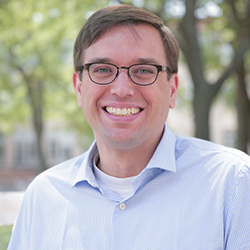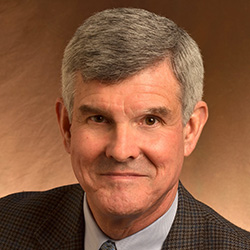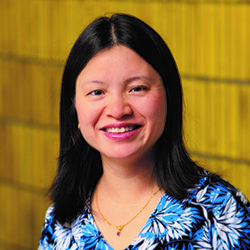
When:
Tuesday, February 14, 2017
4:00 PM - 5:00 PM CT
Where: Technological Institute, Tech L211, 2145 Sheridan Road, Evanston, IL 60208 map it
Contact:
Department Office
(847) 491-3537
matsci@northwestern.edu
Group: Department of Materials Science and Engineering (MatSci)
Category: Lectures & Meetings
Description:
Exploiting X-Ray Coherence in Nanomaterials Science
By: Paul Evans
Abstract: The development of novel functional materials presents a series of characterization challenges, particularly in understanding how to employ the relationship between structural parameters and functional properties such as ferroelectricity and magnetism. X-ray scattering methods based on diffraction, scattering, and spectroscopy have in the past provided structural insight into large and static ensembles of nanomaterials but have had limited applicability to individual nanostructures or to non-equilibrium conditions. The rapid development of x-ray sources with improved x-ray optical coherence now makes it possible to probe nanomaterials under a much wider range of conditions, including transient far-from-equilibrium states and the structure and properties of individual 10-nm-scale nanostructures. My group’s research emphasizes the development and application of these advanced x-ray scattering methods. In this talk I will first describe x-ray nanobeam techniques enabled by x-ray coherence and the application of these tools to challenging problems in the structure of materials for quantum electronic devices. Recent developments in the forward simulations of diffraction experiments, including both coherent scattering and dynamical diffraction phenomena, provide a guide to the interpretation of experimental data. Coherence has likewise enabled us to probe the dynamics of equilibrium fluctuations in ferroelectric nanomaterials and of non-equilibrium states in ferroelectric and multiferroics reached by transient optical or electric-field excitation. By combining nanobeam techniques with time-resolved scattering we have discovered that both optical and electrical excitation leads to large lattice distortions and to structural phase transformations that promise new ways to control electronic and magnetic properties.
Bio: Paul Evans is a Professor in Materials Science and Engineering at the University of Wisconsin-Madison, where his research interests are at the intersection of the development of electronic materials and the creation and application of novel methods in x-ray science. Before moving to the University of Wisconsin in 2002, Evans received his doctorate in Applied Physics in from Harvard University in 2000 and spent two years as a postdoctoral research in the Physical Sciences Research Division at Bell Laboratories. His professional activities have included advisory roles at several synchrotron light sources and an extended sabbatical visit to the European Synchrotron Radiation Facility.

When:
Tuesday, February 21, 2017
4:00 PM - 5:00 PM CT
Where: Technological Institute, Tech L211, 2145 Sheridan Road, Evanston, IL 60208 map it
Contact:
Department Office
(847) 491-3537
matsci@northwestern.edu
Group: Department of Materials Science and Engineering (MatSci)
Category: Lectures & Meetings
Description:
Measurement of Power Law Creep Parameteres by Nanoindentation
By: George Pharr
Abstract:
Over the past decade, great progress has been made in making small-scale mechanical property measurements by nanoindentation at elevated temperatures; in fact, several systems for doing so are now commercially available. These advances have paved the way for studying and measuring the material parameters that describe power law creep behavior, e.g., the stress exponent for creep, n, and the activation energy for creep, Qc, using small-scale experiments. The ability to make such measurements with nanoindentation provides for high point-to-point spatial mapping as well as the characterization of thin films and thin surface layers. However, serious experimental difficulties are encountered in making such measurements, particularly those associated with thermal drift, and how one converts the data obtained in nanoindentation testing to the parameters used to characterize uniaxial creep is not at all straightforward. In this presentation, we discuss recent progress in making meaningful measurements of power law creep parameters by nanoindentation. Special attention is given to the models and data analysis procedures needed to convert nanoindentation load-displacement-time data to the parameters normally measured in uniaxial tension or compression tests. * Research sponsored in part by the National Science Foundation under grant number DMR-1427812.
Bio:
George M. Pharr is TEES Distinguished Research Professor in the Department of Materials Science and at Texas A&M University, College Station, TX. He received his BS in Mechanical Engineering at Rice University in 1975 and Ph.D. in Materials Science and Engineering from Stanford in 1979. After one year of postdoctoral study at the University of Cambridge, England, he returned to Rice in 1980 as a faculty member in the Department of Mechanical Engineering and Materials Science. In 1998, he moved to the Department of Materials Science and Engineering at the University of Tennessee (UT), where he served as Chancellor's Professor and McKamey Professor of Engineering. While at UT, he also held a Joint Faculty Appointment at the Oak Ridge National Laboratory (ORNL). He was Head of the UT Materials Science and Engineering Department during 2006-2011 and Director of the UT/ORNL Joint Institute for Advanced Materials from 2009 to 2016. He moved to his current position at Texas A&M in January 2017 as part of the Texas Governor's University Research Initiative.
Dr. Pharr received ASM International’s Bradley Stoughton Award for Young Teachers of Metallurgy in 1985. His honors also include the Amoco Award for Superior Teaching at Rice University in 1994, a Humboldt Senior Scientist Award in 2007, the Materials Research Society's inaugural Innovation in Materials Characterization Award in 2010, and the University of Tennessee Macebearer Award in 2015. He is a member of the National Academy of Engineering (2014) and a Fellow of ASM International (1995), the Materials Research Society (2012), and TMS (2016). Dr. Pharr has been an Associate Editor of the Journal of the American Ceramic Society since 1990 and Principal Editor of the Journal of Materials Research since 2012. He is an author or co-author of more than 200 scientific publications, including 4 book chapters. His research focuses on mechanisms of plasticity and fracture in solids, especially at small scales.

When:
Tuesday, March 7, 2017
4:00 PM - 5:00 PM CT
Where: Technological Institute, Tech L211, 2145 Sheridan Road, Evanston, IL 60208 map it
Contact:
Department Office
(847) 491-3537
matsci@northwestern.edu
Group: Department of Materials Science and Engineering (MatSci)
Category: Lectures & Meetings
Description:
Foldable and Responsive Soft Metamaterials
By: Shu Yang
Abstract: Materials that can expand and collapse, fold, and transform into a variety shapes have attracted significant interest and have obvious applications in flexible electronics, color displays, smart windows, actuators, sensors, and both photonic and phononic devices. But how can we render a rigid device super-flexible so that it can wrap around a sphere without bending and stretching? How can flat surfaces be transformed into any desired 3D structure without disruptive stretching and deformation?
In my talk, I will show several examples how we introduce holes and cuts in periodically structured materials, so called metamaterials, exhibiting dramatic shape change (e.g. ~800% areal expansion) and super-conformability via expanding or collapsing of the periodic hole arrays without deforming individual lattice units. When choosing the cuts and geometry correctly, we show folding into the third dimension, known as kirigami. The kirigami structures can be rendered pluripotent, that is changing into different 3D structures from the same 2D sheet. We then pre-program the buckling direction and curvatures by introducing notches on existing kirigami structures or by embedding cues in surface patterns of liquid crystal elastomers with internal strains. Lastly, I will show our initial success in additive manufacturing toward textile based self-folding devices.
Bio: Shu Yang is a Professor in the Departments of Materials Science & Engineering, and Chemical & Biomolecular Engineering at University of Pennsylvania, and Director of Center for Analyzing Evolved Structures as Optimized Products (AESOP): Science and Engineering for the Human Habitat. Her group is interested in synthesis, fabrication and assembly of polymers, liquid crystals, and colloids with precisely controlled size, shape, and geometry; investigating the dynamic tuning of their sizes and structures, and the resulting unique optical, mechanical and surface/interface properties. Yang received her B.S. degree from Fudan University, China in 1992, and Ph. D. degree from Chemistry and Chemical Biology while researching in the Department of Materials Science and Engineering at Cornell University in 1999. She worked at Bell Laboratories, Lucent Technologies as a Member of Technical Staff before joining Penn in 2004. She received George H. Heilmeier Faculty Award for Excellence in Research from Penn Engineering (2015-2016). She is elected as Fellow of National Academy of Inventors (2014) and TR100 as one of the world’s top 100 young innovators under age of 35 by MIT's Technology Review (2004). She was a recipient of ICI (1999) and Unilever (2001) student awards from American Chemical Society (ACS) for outstanding research in polymer science and engineering.